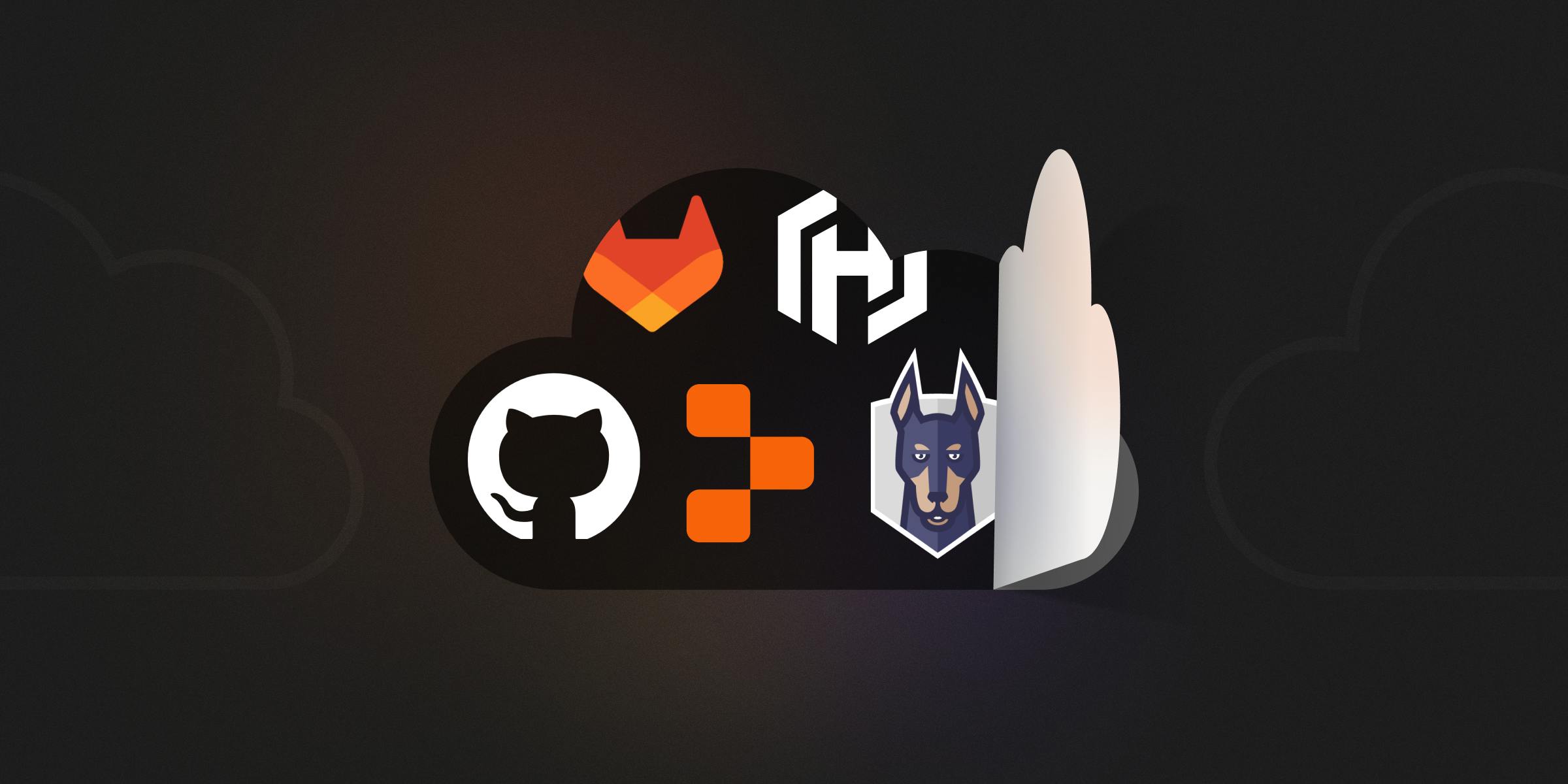Thesis
In the early days of computing, the vision for how humans would interact with computers looked nothing like the paradigm we've known for the past 50 years. One of the founding documents of computing was Alan Turing’s “Computing Machinery and Intelligence.” In it, Turing didn’t describe the point-and-click paradigm we have today. Instead, the earliest visions of computing machines were framed as reasoning agents, responding dynamically to human input. Similarly, when John McCarthy, Marvin Minsky, Nathaniel Rochester, and Claude Shannon coined the term “artificial intelligence” in a 1955 research proposal, they described machines that, rather than relying on step-by-step human prompting, could autonomously perform tasks, learn, and even reason like a human.
That vision never materialized, due to a combination of hardware constraints, especially insufficient processing power, as well as slow progress in AI through the 1980s and 1990s, and the commercial success of the graphical user interface (GUI). People settled for a direct manipulation paradigm, where users manually interact with graphical interfaces via mouse and keyboard. Even in these simpler forms, Steve Jobs described computers as “a bicycle of the mind… something that takes us far beyond our inherent abilities.” But the vision for a computer wasn’t meant to be a tool you handle, like a pencil. It was meant to automate away aspects of work that humans don’t need to do.
What’s old is becoming new. Increasingly, computing is returning to the original vision of its founding days — autonomous reasoning machines that can perform tasks independent of direct human manipulation. In June 2023, McKinsey estimated that AI could add up to $4.4 trillion of economic value globally, largely driven by AI agents. Andrew Ng, a highly respected AI academic and practitioner, described agentic AI as “the most important trend to pay attention to” in November 2024. The introduction of agents in almost every use case is expected to be the primary driver of value as AI is increasingly deployed, and it is expected to increase in volume by 45% over the next five years.
Replit* is pushing forward the usefulness of AI agents in one key category — software creation. Since the beginning, Replit’s mission has been to democratize access to programming and empowering a billion software creators. Amjad Masad, the CEO of Replit, believes that AI is the unlock to that democratization. As he describes it, “if you can use a computer you should be able to make software.” The Replit Agent is a code generation agent that produces an application from an idea expressed in natural language, essentially functioning as an AI app builder. By removing the barrier of becoming a professional software engineer, Replit can enable the fruition of the original vision of computing — autonomously generated software applications that can perform specific tasks.
Founding Story
Internet Pioneer in Jordan
Replit was founded as a company in 2016, but the seed of the idea started when Amjad Masad was 12 years old. Growing up in Jordan, Amjad describes his upbringing as spending a lot of time outside. That is, until he discovered computers. When he was young, Amjad’s father brought home a new IBM computer and he was hooked:
“I figured out how to program it [and] started my first business when I was 12. I would go into these gaming cafes and [you] would write your name in a notebook, play a little, and then someone would tap your shoulder to say you’re done. [I told them] ‘this is ridiculous, you should be using software.’ I went into a hole and a year and a half later emerged. I went to these places where I used to play games and managed to sell licenses. [It was] $500 a year, which was like infinite money for me at the time. The first thing I did with the money is I took my entire class to McDonalds.”
Amjad’s early experience building software involved a crash course on every point of friction imaginable that developers face. The hole he went down for a year and a half extended to “setting up a database, collaborating on code, bringing in packages, maintaining everything, and pushing to production.” For developers, these are many of the components of setting up a development environment. The status quo has been fairly static integrated development environment (IDE) that has many of these features bundled together. But with or without a dedicated IDE, the process of developing software has always been riddled with friction. That was Amjad’s formative experience, wrestling with the friction of programming, and it ended up creating the fundamental philosophy that has informed the majority of his career since then. As he described in October 2024:
“There’s people with so many amazing ideas in the world, but how difficult coding is puts up this wall in front of a lot of creative people that could be bringing new products into the world. The more people making things, the better the world is.”
The Birth of repl.it
Having discovered his passion for building technology, he started working in tech. After graduating from college in 2010, Amjad started working at Yahoo! in Jordan in 2011. While there, his frustration with the friction in everyone's coding experience continued to bother him. While at Yahoo!, Masad spent his free time trying to learn four new programming languages every year. However, Masad realized the lack of a portable development environment made it difficult for him to achieve his goal.
With the help of his classmate, Max Shawabkeh, Masad developed a solution to his problem by creating a program capable of supporting a cloud-based coding environment accessed from a web browser. The earliest version of Replit was born as repl.it, and the trio open-sourced the project.
The company’s name is derived from a REPL which stands for Read-Eval-Print-Loop. More specifically, a REPL is an interactive environment that takes the inputs from the user, executes them, and returns the results back to the user. Overall, the vision was to enable iteration to be as quick as possible. Masad described the product in a February 2021 blog post this way:
“Every repl created on Replit is a full computer that comes with access to the network, a database, and storage, as well as access to its code and user profiles.”
When he was younger, Amjad saw the low-budget movie Pirates of Silicon Valley. The dramatized story of Steve Jobs versus Bill Gates “shouting at each other and building billion dollar companies” caught his attention and set his sights on trying to make it to Silicon Valley. The first step was getting to the US. Luckily, around the same time Amjad and his early collaborators were open-sourcing repl.it, a company called Codecademy was just getting started.
Codecademy was first started using repl.it open source. Amjad found Codecademy on Hacker News when it was going viral, and described it as surreal where he could tell when he opened up the product that they were using what he had built. He commented excitedly on Hacker News, “you’re using my library!” After that, the Codecademy team started paying Amjad as a freelancer before trying to convince him to come on full-time. Amjad was determined, instead, to start his own company. But Codecademy CEO, Zach Sims, flew out to Jordan to convince him. After three days of negotiating and convincing, Amjad finally signed on the way to the airport and from there headed to New York. Sims describes his perspective this way:
“We used jq-console―repl.it’s web terminal plugin—for the first version of Codecademy, and we were blown away by both Amjad and the IDE.”
Replit Forces Itself Into Existence
Amjad described his experience at Codecademy as “so much fun, but it was so tiring.” The idea of working at a larger company appealed to him. In particular, the vision that Mark Zuckerberg started laying out in 2013 with internet.org was directly in line with Amjad’s driving thesis:
“I am passionate about this idea of computing and the internet being this huge force for good around the world. Getting people out of poverty, being able to have earning potential online, and democratizing access to wealth creation.”
However, as soon as he got to Facebook he, instead, started working on developer tools again. At the time, even a single line of Java code for Android could take 15 minutes to compile. There was a team at Facebook called Catalyst, which ended up developing React Native. Amjad became a founding engineer helping to develop what became the top cross-platform mobile development framework.
All of Amjad’s experiences, from struggling through the process of building software for internet cafes or at Yahoo! to trying to democratize coding through Codecademy or React Native, seemed to culminate in the reality that Replit had to exist. Despite having paid little attention to the open-source repl.it from 2011 to 2016, it still organically had 10K users. With a little attention, that quickly grew to 100K users before Amjad had even quit his job at Facebook. As Amjad described:
“We started Replit officially in 2016 because this thing just wouldn't die and kind of exploded itself into the world.”
Unofficially, Amjad, his wife, Haya Odeh, and his brother, Faris Masad, started working on Replit in 2015. Officially, Amjad quit his job at Facebook in 2016 and formally incorporated Replit as a company. Amjad describes the early days as a grind. The first two years were spent building a lot of infrastructure while not generating a lot of “Silicon Valley hype.” The company had applied to Y Combinator three times but had been rejected each time.
Around this time, Amjad got into the habit of “writing something every couple of weeks about some of the engineering challenges [they] were facing.” His writing did well on Hacker News and attracted the attention of Paul Graham, the founder of Y Combinator. Earlier in his career, Graham had actually envisioned building something exactly like Replit. So Sam Altman, the president of Y Combinator at the time, reached out and encouraged Amjad to start a conversation with Graham.
Graham encouraged Amjad to apply to Y Combinator. At the time, Replit had already raised a pre-seed round from Bloomberg Beta and had its first profitable month, so the team wasn’t sure they wanted to give YC its standard 7% equity. The team agreed on the condition that Paul Graham would be available to them, and Graham and Altman agreed. Altman asked Amjad to fill out a YC application “just as a formality.” Tired of recording an application video after three rejected applications, Amjad instead linked to the YouTube video for Never Gonna Give You Up as a joke. In the interview process, Michael Seibel yelled at the team for the joke, making them think they’d once again been rejected. But, to the team’s surprise, they were accepted into YC’s Winter 2018 batch.
As of February 2025, Replit’s team has expanded to include previous founders, designers, and engineers from companies such as Google, Mozilla, Facebook, Spotify, Box, and Scratch. In addition, in June 2023, Replit hired Michele Catasta as the company’s VP of AI, and later as President. Catasta had previously been the Head of Applied Research at Google Labs. He and Replit CEO, Amjad Masad, also co-authored the company’s AI Manifesto.
Product
Replit’s product has evolved over the years in pursuit of a specific mission to “enable the next billion software creators.” From building collaborative in-browser coding environments to code explanation via early AI tools like Ghostwriter to network-based bounties to get help writing code; each aspect of Replit’s product over the years has been focused on making the process of creating software as frictionless as possible. As of February 2025, that journey has resulted in a software development platform with AI at its center and a fairly broad set of use cases it can address.
Replit AI
Replit’s AI platform has two core components: (1) Replit Agent and (2) Replit Assistant. Each is built into the broader Replit engine, which is a virtual environment or container for software development that includes the “tools, services, and packages” needed to build applications. The product can be thought of as an AI app builder or no code app builder.
Replit Agent
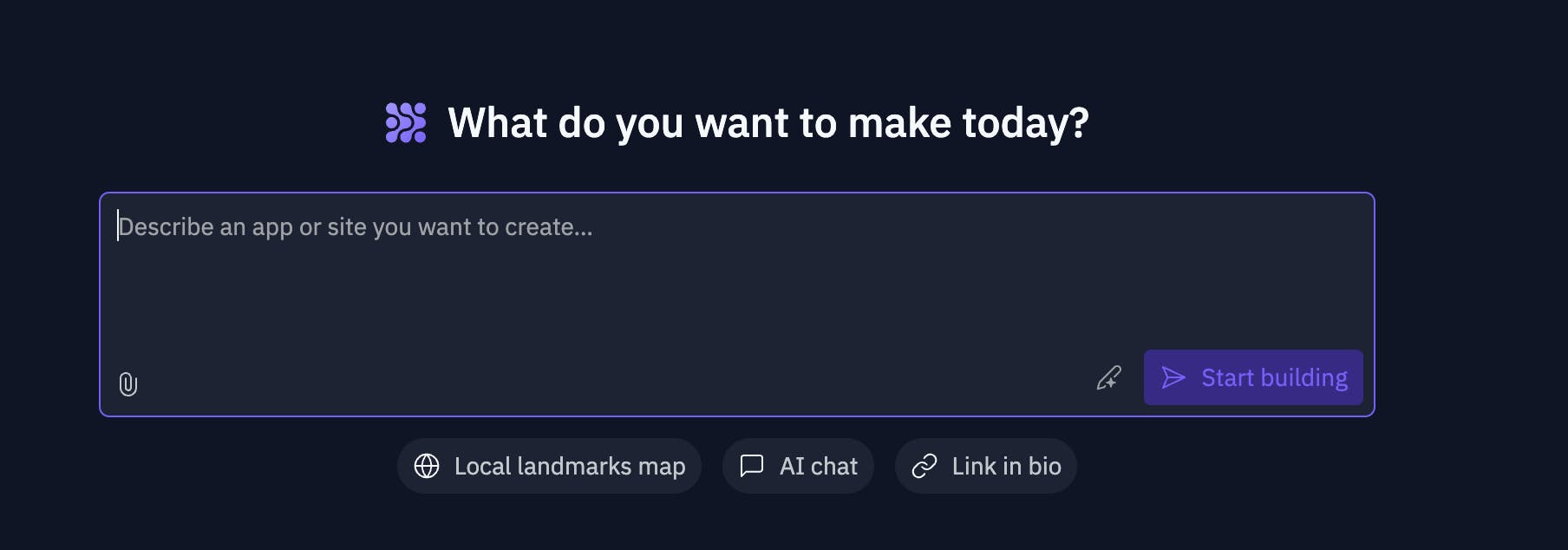
Source: Replit
Replit Agent is an autonomous AI system that can plug into each feature within the Replit engine for use cases like “creating a database, connecting a front-end and a back-end, or deploying an application.” Agent responds to natural language prompts to create code for a specific application and includes specific packages, integrations, and deployment capabilities, functioning as an AI coding tool. In February 2025, Replit announced Agent v2 using Anthropic’s Claude 3.7 Sonnet claiming the update provided an agent that is “fundamentally more autonomous.” Development with the Replit Agent follows several iterative steps:
Natural Language Prompt: When users first log in to Replit, they’re met with a specific prompt: “what do you want to make today?” From there, users can describe in varying degrees of detail what they’re trying to build, regardless of their coding knowledge, using just a prompt. Replit Agent also provides a “Improve prompt” function where a simpler prompt can be expanded to include more detail.
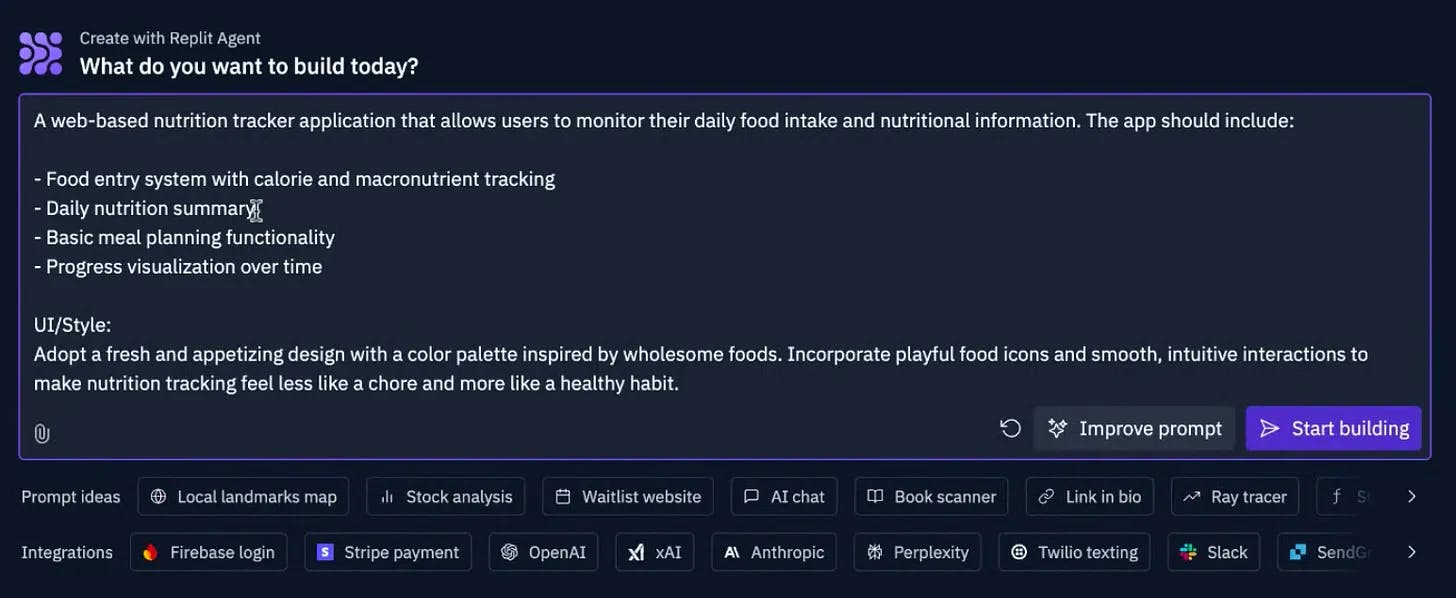
Source: Creator Economy
Plan Approval: Once a prompt is submitted, Replit Agent provides a high-level summary of the plan it proposes to execute, including specific languages, packages, and approaches to building the desired application. For example, it may pick Streamlit, an open-source Python framework, based on the requirements of the project. The user can respond, requesting React as a new plan, or approve the recommended approach.
Initial Prototype Iteration: Once a plan is agreed upon between the Agent and the user, the Agent will describe the process it goes through, such as adding support for python-3.11, installing Streamlit, configuring deployment capabilities, etc. From there, the Agent will return to the user requesting feedback on the application. It will also create a “Rollback” point where, if in the future a user wishes to undo a series of changes, they can roll back to this version of the application.
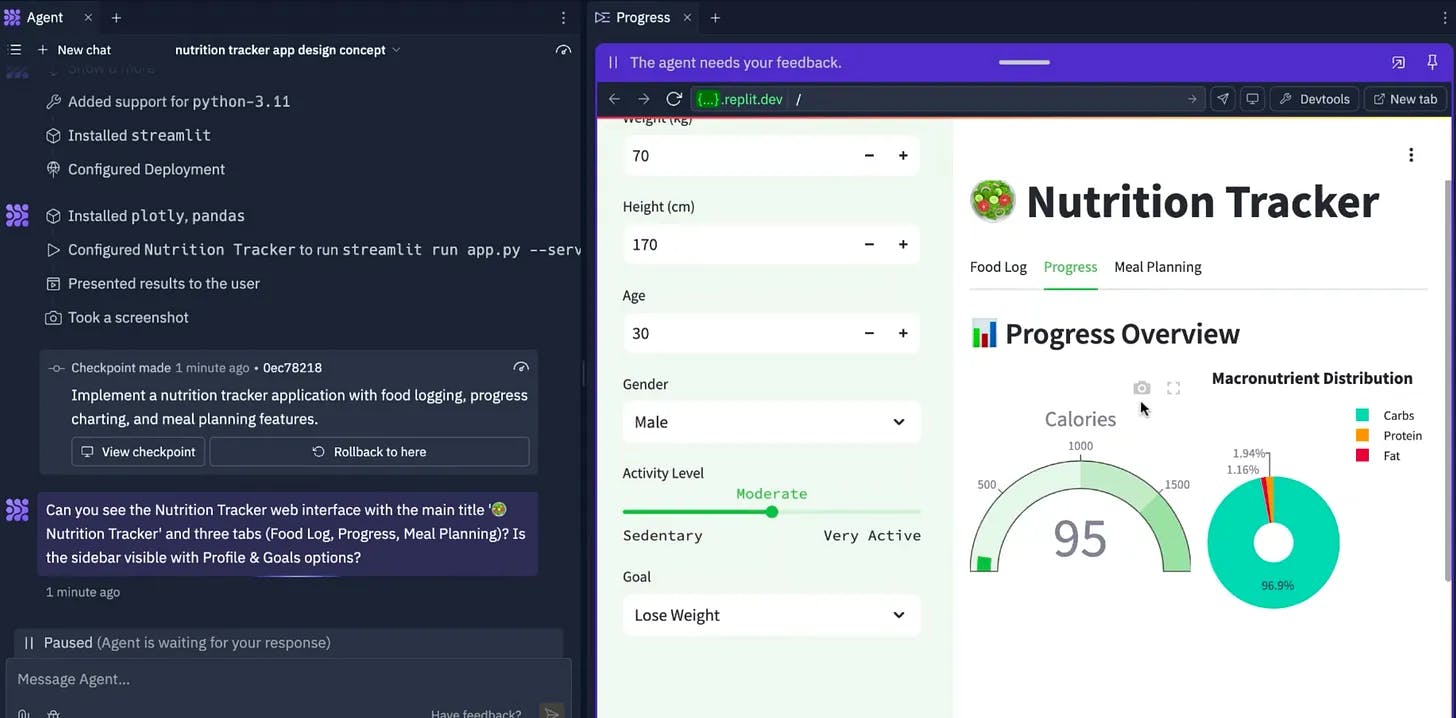
Source: Creator Economy
Feedback Cycles: From there, the user can go back and forth with the agent making specific requests, changes, additional functionality, or any other improvements to the application. Throughout this process, you can also highlight snippets of code and ask for an explanation, either from Replit Agent or Replit Assistant. You can also debug certain issues that may arise with the application.
Database Creation: For many code generation applications, this is where the process would end. Replit Agent can create “databases, determine deployment needs, handle migrations, and manage integrations.” Databases such as Postgres, as well as object storage and Replit Key-Value Store. In February 2025, Replit announced the launch of its database editor, enabling users to manage their databases “with the ease of use of a spreadsheet.” As Replit CEO, Amjad Masad, explains:
“[Other coding agents] focus on code generation, but you're not usually using them to make end-user software because you have to take it somewhere else. Sometimes people make something with V0, improve it in Cursor, then deploy it on Vercel. With Replit, the entire software development lifecycle is in one place.”
Deployment: Once an application is complete the user can hit Deploy and Replit Agent will automatically build a package and ship it to Google Cloud, Replit’s partner for backend deployments. From there, users can select the right deployment type (reserved virtual machine, autoscale, static pages, or time-based job schedulers), determine the required machine power, and edit features like the domain.
Analytics: Replit also provides an analytics function for deployed projects to help Replit users better understand their user bases. With the analytics dashboard, Replit users can understand data points across things like page views, browsers, traffic referrers, and request durations.
The types of applications Replit is capable of building extend to not only web apps but also mobile apps (which can even be created on Replit’s mobile app), Slack apps, and other platforms.
In deciding to name the product Replit Agent while other companies often give their products names, like Claude or Devin, Amjad explained that AI products often set the bar too high, which raises people’s expectations. He pointed to examples like Tesla going through iterations of product names for autonomous driving as Smart Summon before renaming it to Dumb Summon and eventually launching Actually Smart Summon. Amjad explains how Replit Agent is meant to be seen as an iterative product where the company acknowledges that it will continue to improve:
“If we made it as if it's an actual person then people will have a much higher expectations of the the product. You can get into this treadmill of naming things when you set the bar too high. We want to set the expectation that this is something that is trying its best to do what you ask, but not necessarily always succeeding.”
Replit Assistant
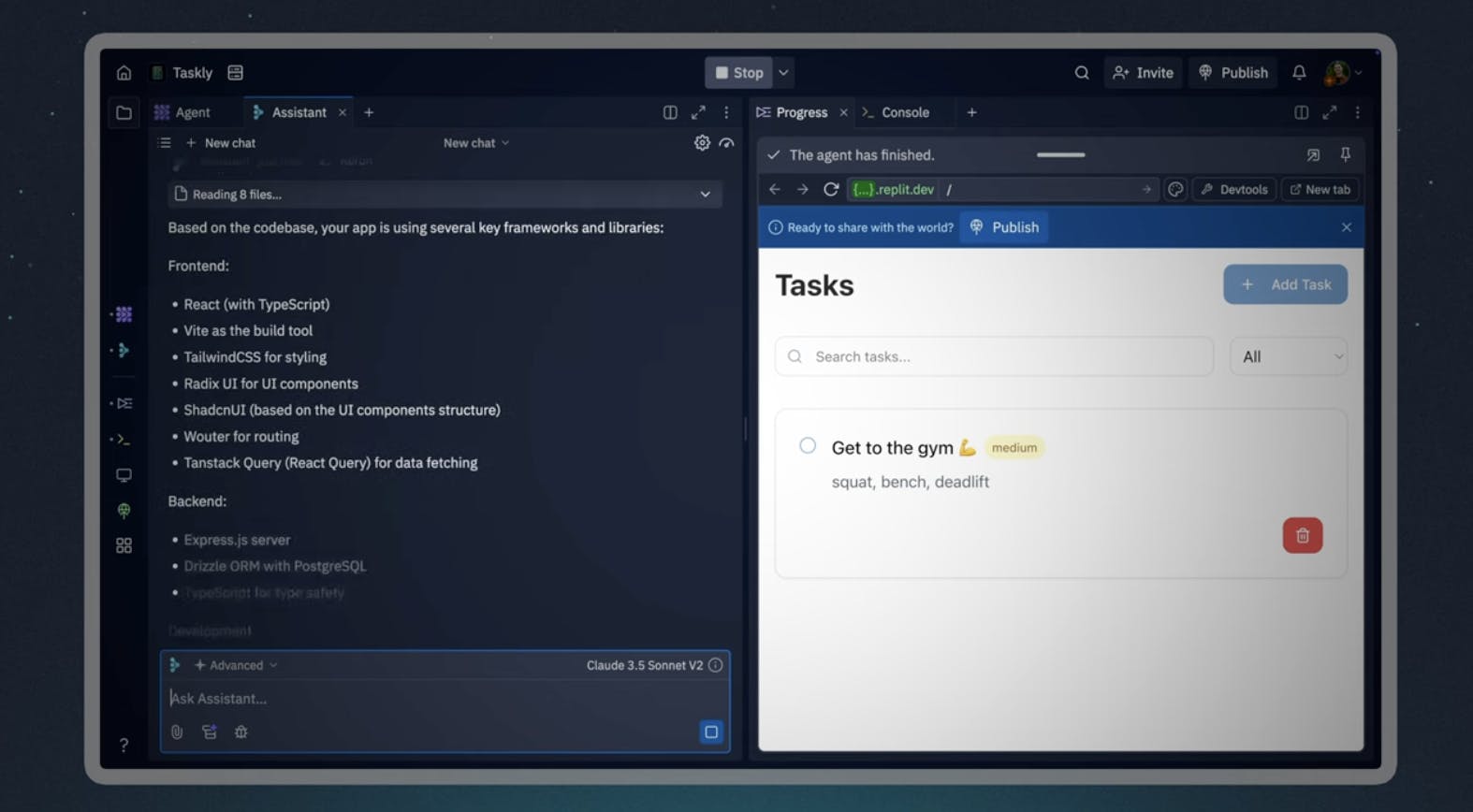
Source: Replit
Replit Assistant is a chatbot for asking questions about the application being built, or helping to understand specific aspects of the code or code suggestions. Assistant is more lightweight than Agent but can also make simple changes as part of the application being built. Amjad Masad describes the difference between Replit Agent and Replit Assistant this way:
“You could think of the assistant as the cousin of the agent. Agent is doing things on your behalf. It has a lot of agency, [and] it's going to make a lot of decisions without consulting you. Assistant is more like a co-pilot where it's not going to make any changes until you ask it to. It is much better at chatting, [and] you can brainstorm with it.”
Collaboration

Source: Replit
Replit is browser-based, rather than locally hosted on a user’s machine. This allows users to access the same coding environment simultaneously, similar to Google Docs. Users can see each other interacting with a particular piece of code, but can also share a compute engine so they can run one function and see the same results. In addition, users can collaborate in the same Replit Assistant chat alongside colleagues as they troubleshoot a shared problem.
In particular, Replit Teams provides extensive collaboration capabilities. The goal of the product is to help teams build, share, and deploy software efficiently from any device. It offers a broad suite of tools tailored for various aspects of software development:
Production Applications: Teams can deploy static sites for free or opt for auto-scaling deployments and reserved virtual machines for more demanding applications.
Internal Tools: Replit enables the rapid creation and deployment of internal tools, with features like Replit App Auth to manage access seamlessly.
Rapid Prototyping: With instant cloud environments, teams can test and iterate on new ideas, facilitating agile development practices.
Cloud Development Environment (CDE)

Source: Replit
For any software developer, the primary operating environment is within their integrated development environment (IDE). This is where developers write source code, debug, and compile. Different IDEs may be most popular for particular use cases, like PyCharm for Python, or Xcode for Mac and iOS development. Popular IDEs include Microsoft’s Visual Code Studio (also known as VS Code), which has 14 million users and launched a lighter version of its code editor in October 2021 that runs in the browser.
Replit was unique in the first few years in providing a browser-based IDE, what the company now refers to as a cloud development environment (CDE). This allows users to get support for their preferred frameworks with Replit’s “automatic package installer,” which doesn’t require specific downloads, configuration, or setup. Replit allows users to customize their environments, whether visually by changing the color schemes and configurations, or by utilizing the ability to add specific extensions to enable their environment with specific capabilities, like managing JSON editing, or streaming repl editing. In April 2023, Replit announced a “permissioned security model for an IDE extensions system with isolated permissions by tab” that would ensure extensions didn’t create access vulnerabilities to a user’s environment.
Deployments
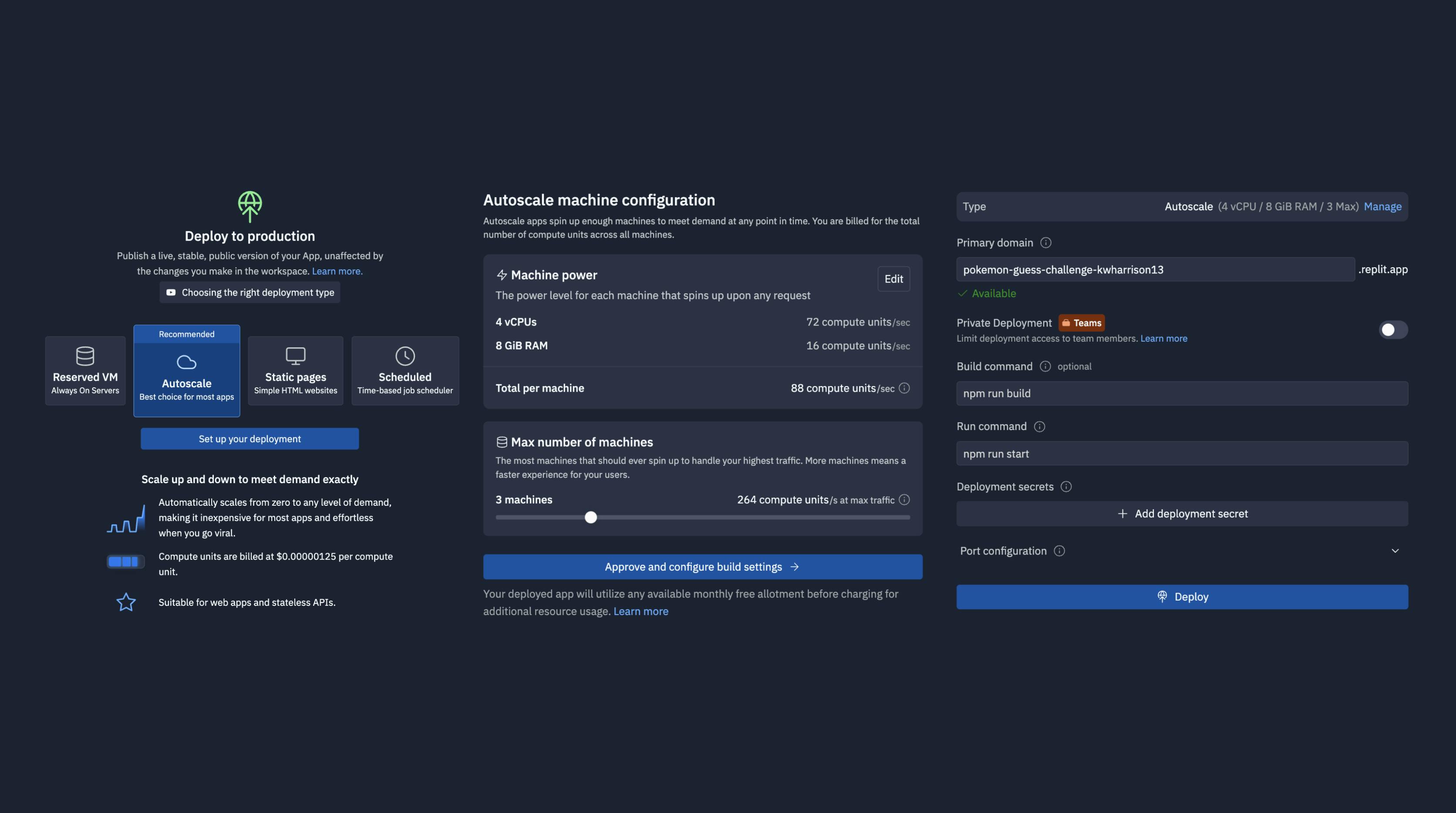
Source: Replit
Once an application is developed, it needs to be deployed. Some IDEs, like VS Code, have integrations with Azure for cloud computing to deploy applications because both products are owned by Microsoft. However, other IDEs outside of the Microsoft ecosystem typically require users to leverage third-party remote hosts in order to deploy their code.
With Replit, a user can leverage Deployments to reserve a virtual machine that will provide server capacity for their applications and then set up autoscaling for their projects to make sure that their application can scale to meet traffic demand. Replit claims its reservations system ensures 99.9% uptime to avoid any application interruptions. With Replit Deployments, a user can scale the CPU and RAM of their app servers, set up custom domains, monitor their applications, leverage security via Google Cloud Platform (GCP), and run analytics on their applications’ usage and growth.
In March 2023, Replit announced a partnership with GCP that would enable Replit users to get access to infrastructure and services from GCP as part of Replit’s attempt to enable developers to go from an early idea to a full application in production. As part of the press release, Replit described the capabilities this GCP partnership would provide:
“Powered by Google Cloud Platform, Replit developers can deploy and scale their applications with a few clicks and get Google Cloud's leading reliability, security, and other benefits.”
In July 2023, Replit announced several upgrades to Deployments, indicating a 3x increase in speed since the initial launch. The upgrades included additional RAM and CPU capacity, as well as logging functionality built directly into the Deployments pane to better manage both the build process and application performance.
Mobile App
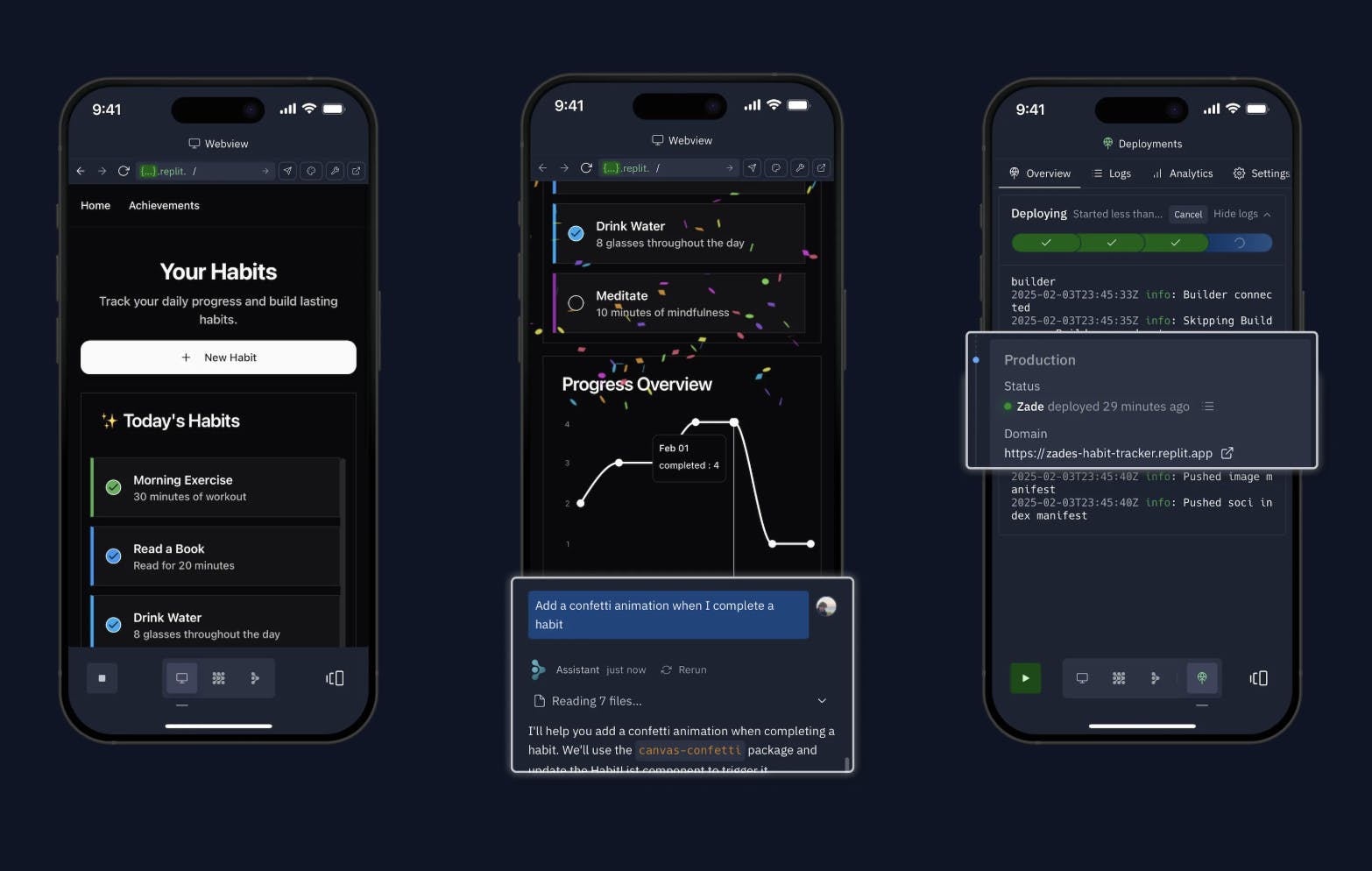
Source: Replit
In October 2022, Replit announced the launch of its mobile app, making coding available to users even if they didn’t have a laptop. As of July 2022, over 10% of Replit’s users were coding on mobile devices. In February 2025, Replit announced that Replit Agent would be available on mobile across both iOS and Android. Around that same time, the Replit app was at the top of the App Store ratings for developer tools.
Going back to Amjad’s driving thesis of democratizing access to programming, he pointed out in February 2025 the importance of enabling people where they are. “There are a lot of people that spend zero time on their computer, and they spend it more on their iPhones and iPads.” As a result, Replit emphasizes the novel approach to providing a fairly complex coding capability on “such a small screen.”
Bounties
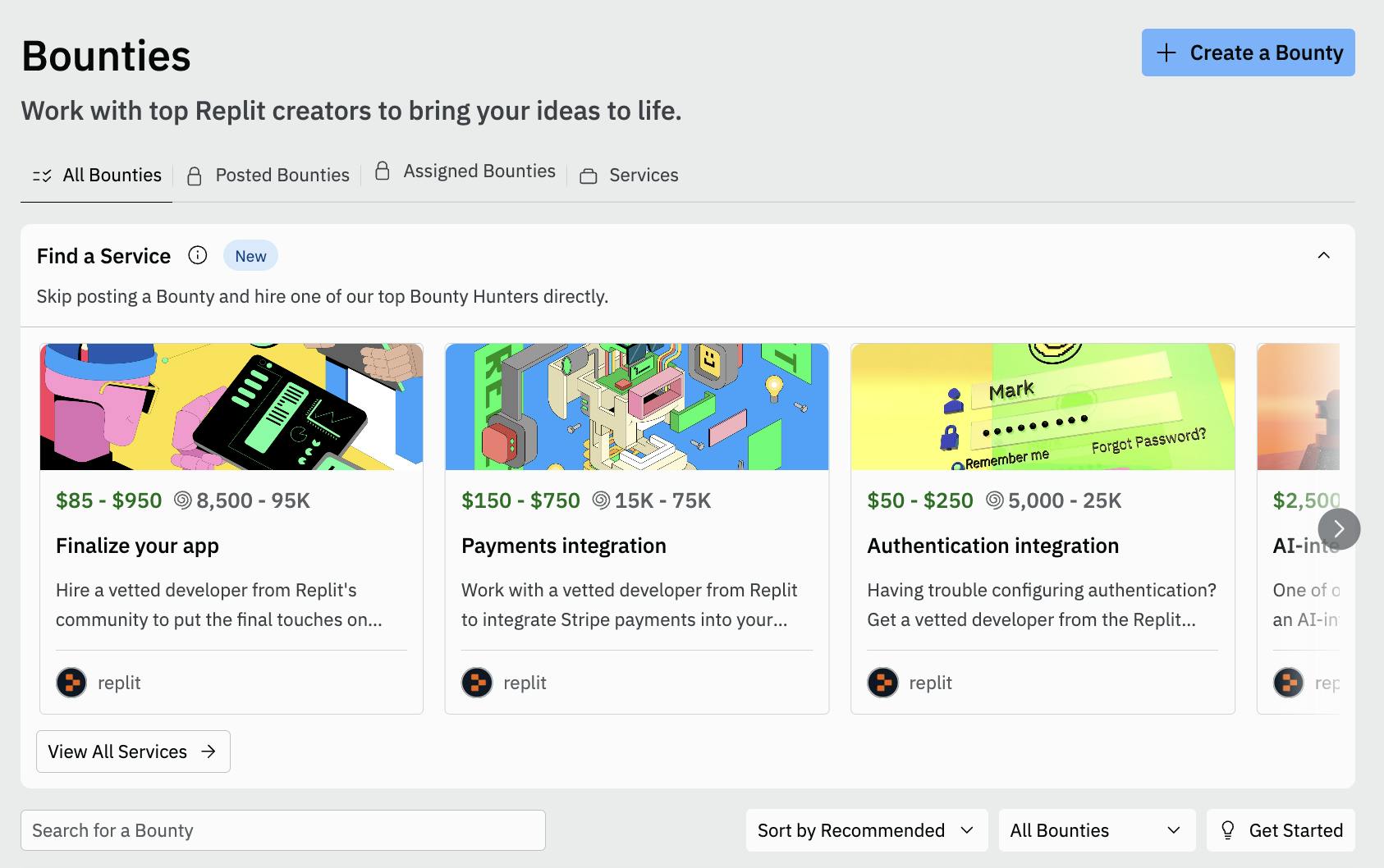
Source: Replit
Replit announced Bounties in December 2022, a creator marketplace where Replit users can post a bounty where they describe what they need in order to receive submissions from the Replit community who attempt to solve the original problem in exchange for that bounty. As of February 2025, the Bounties product isn’t as big of a priority on the Replit website. As Amjad Masad explained in February 2025:
“The transaction cost of doing [software engineering] will go down, making software engineering more amenable to gig work, [where] you can onboard someone onto your code base. Our initial attempt was very simple, [and] we validated something there but I am actually not really happy with the product. The ultimate expression of [bounties] is actually the AI being able to coordinate between the user and the bounty hunter. The Agent will get as far as they can. And then [with your permission], when it fails it will actually go ask a human. We’re probably going to revisit [that] in a few months or up to a year.”
Leveraging AI Models
From the very beginning, Replit had AI as a central focal point of its product. In the company’s pitch deck for raising a seed round in 2016 it included a slide where the master plan was building an “AI assisted interface that blurs the distinction between learning and building.”
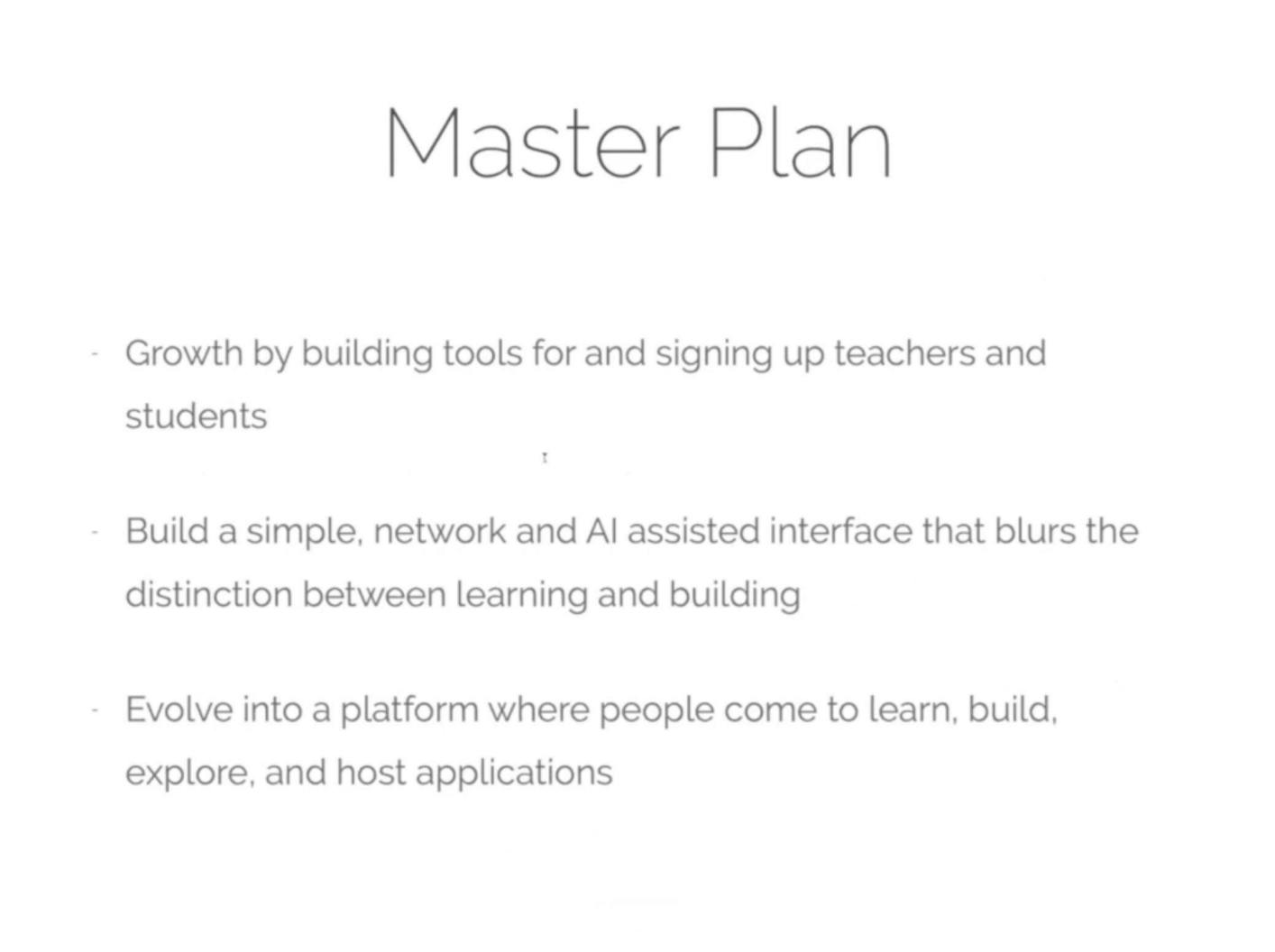
Source: Replit
Amjad describes his time at Codecademy and Facebook as reinforcing his belief that, eventually, machine learning could replace a lot of manual work programmers were doing at the time:
“Every year we would prototype something since the start and it was just never good enough to ship anything. Then GPT-2 came out and it could write coherent code. When GPT-3 came out, we were one of the first companies to build anything on top of it.”
GPT-3 launched in June 2020, but within a few months, Microsoft had licensed an exclusive deal with OpenAI to use GPT-3, which made it impossible for Replit to use the model the way the team wanted to. Instead, the team decided to build its own code generation model. The product was initially built with an optimized version of Salesforce’s CodeGen model and CodeBERT, and launched in September 2022 as Ghostwriter, which could generate code and queries.
Despite improvements the Replit team had made, CodeGen was never quite good enough. Instead, the team was approached by Google about using its PaLM model. As the conversation progressed, Google’s legal team reportedly decided it was too much of a risk and opted not to release an LLM at the time. In fact, Michele Catasta, a member of the Google PaLM team was so frustrated by the decision that he left Google. At the same time, Amjad approached Catasta about joining Replit to build an internal model instead, so he joined as VP of AI. In February 2023, Meta’s LLaMA base model was released and Replit decided to build a small model. What the team built was a 3 billion parameter model that ended up outperforming every other open-source model, including Google PaLM.
As LLM progress continued to race forward, Replit made a strategy shift towards working with other models. One key driver behind that decision is the benefit of transfer learning. General purpose models from companies like OpenAI and Anthropic demonstrate better performance as the result of more information in the model’s training. In September 2023, Replit announced that it would, instead, leverage “the most advanced model on the market.” At the time of the announcement, that model was GPT-4 from OpenAI but the team was intent on continuing to track the progress of other models. Since then, Replit has continued to focus on rapid experimentation, as Amjad explains:
“I think road maps are dead. You want to be able to react to new technology, which happens every two weeks now. We dropped everything and played with [DeepSeek] R1, and decided it's actually very interesting academically but it doesn't come close to Claude Sonnet for coding.”
As of February 2025, Replit indicated that Replit Agent is built using Claude’s Sonnet models. This also provides a key vulnerability where code generation becomes more commoditized and places increased emphasis on Replit’s broader platform, like Replit Agent. For, Replit is building an agent in a way that Amjad describes as a hack:
“Large language models are trained to complete sentences. The way agents are built today is kind of a hack. It’s not trained to be agentic. The way we’re [building] agents is reflection and function calling. OpenAI, Google — they haven’t trained these models to be action systems, which makes them less reliable. We’re working on ways to scale [that hack], and we have a new feature coming up that I’m not prepared to talk too much about, but it will solve the scalability issues with agents today.”
Market
Customers
As Replit’s product has evolved its target customer has as well. In the past, Replit has been a popular tool among young people learning to build software. In December 2021, 50% of Replit’s users were under 18 and new to coding, while 80% were outside the US. While Replit can still serve those users, there was always a question of whether Replit would ultimately have to address professional software engineers in order to build a large business. In January 2025, Amjad made clear where Replit is focused, and where it's not, saying “we don’t care about professional coders anymore.”
The introduction of AI for code generation is, increasingly, driving a bifurcation in the market. On the one hand, there are integrated hardware and software engineers, at organizations like NASA or Tesla, who are unlikely to benefit as much from generative code. On the other, there are citizen programmers who have little to no technical experience but are working to build products. Amjad makes it clear that the middle ground is the most at risk due to AI:
“Full stack developers are the [ones] most at risk because it's the thing that's most represented on GitHub. It's the thing that AI is the most good at, and is already somewhat automated. People using Replit, Cursor, and others are automating bigger and bigger parts of that job. The demand for engineers like that will go down. Instead, companies will look for generalists that can go from ideation to production code by using AI.”
As a result of this bifurcation, Replit is increasingly focused on the “generalists” who can execute on ideas using AI. This could be novice engineers, product managers, marketing specialists, or indie hackers. Amjad described a core characteristic of an ideal Replit customer:
“Finding software problems in your life is also a skill, looking at a problem and saying, ‘a piece of software could solve that’ is a skill.”
Those aren’t, necessarily, just side projects. Replit has made it clear that it has a scalable system that has enabled companies to grow to “tens of millions in ARR running on Replit.” Customers like MagicSchool have ramped to significant funding and even raised $20 million in funding, all while running on Replit.
Market Size
Like most other aspects of Replit’s business, the addressable market has evolved over time. On the one hand, Replit provides a coding environment, addressing the traditional IDE market —a market is estimated to grow to over $23 billion by 2029. However, Amjad doesn’t consider Replit to be a traditional IDE. In September 2020, he described the product this way:
“If your IDE is a car, Replit is a motorcycle. If your IDE is a desktop computer, Replit is an iPad. If your IDE is a skyscraper, Replit is a cozy vacation house.”
The market for software development more broadly was estimated ~$737 billion in 2024. The broader question is what happens to software development when AI gives a much broader audience of users the ability to build software? Two key drivers behind the addressable market for Replit include (1) an increased demand for software, and (2) a related increase in the number of people who want to build software. However, an open question that may impact the growth of this market is whether generative AI will automate software development entirely, meaning fewer software developers. In economics, there is a concept called Jevons paradox, with the core idea being that efficient production of a resource (like generative software code) actually increases demand for that resource:
“The Jevons paradox occurs when technological progress or government policy increases the efficiency with which a resource is used (reducing the amount necessary for any one use), but the falling cost of use increases its demand—increasing, rather than reducing, resource use.”
So, as generative AI makes code easier to produce, it could actually increase the demand for software, rather than reduce it. As software becomes easier to develop, because of tools like Replit, that will also likely increase the number of people who want to develop it.
Competition
Aspects of Replit’s product competes with a variety of tools, including many AI coding tools. Some would point to an extensive platform like Microsoft’s VS Code, which is unique among development platforms because it has competitive offerings to the majority of Replit’s features (e.g. Visual Studio Web Browser compared to Replit’s CDE, integrations with Azure compared to Replit Deployments, Visual Studio IntellliCode compared to Replit Agent). Otherwise, each aspect of Replit’s product has its own competitive set.
Replit Agent
Since LLMs have become more common in coding workflows, a number of companies have emerged providing code completion agents. The core capability of these platforms is an agentic approach to producing specific segments of code. However, they vary in terms of who their intended target user is and how much of the full production lifecycle they’re intended to address.
Cursor by Anysphere: Founded in 2022, Anysphere is the parent company of Cursor, an AI code editor built on VS Code. The product can autocomplete lines of code, and implement the next logical edits. It can also connect to existing codebases and documentation. The product is used by engineers at companies like Vercel, Shopify, Midjourney, Perplexity, Ramp, and others. Typical Cursor users are software engineers looking for tools that make their lives easier. Users can interact directly with code, edit code install packages, and have more direct control over the development lifecycle. For use cases like deployment, users would pursue a traditional process for building out a database and hosting. Non-technical users would likely have a harder time using Cursor compared to other tools. Cursor is built on Anthropic’s Claude 3.5 Sonnet. Anysphere has raised $173 million in funding as of February 2025.
Windsurf by Codeium: Codeium announced Windsurf in November 2024. The product is an AI-powered code editor developed by Codeium, designed to streamline the software development process. Windsurf’s AI agent is Cascade, which provides multi-file, multi-edit capabilities. Like Cursor, Windsurf is built on top of VS Code, offering intelligent autocompletion, code generation, in-editor AI chat, and context-aware code modifications. It integrates with existing codebases, making it easier to navigate, refactor, and generate code efficiently. Windsurf is built on Anthropic’s Claude 3.5 Sonnet. Codeium has raised a total of $243 million in funding as of February 2025.
v0 by Vercel: In October 2023, Vercel announced v0, a generative UI platform. “v0 produces code using open-source tools like React, Tailwind CSS, and Shadcn UI.” While other generative code tools typically build front-end and back-end capabilities, v0 is focused on front-end user interfaces. Most likely, v0 is leveraging Claude 3.5 Sonnet.
Lovable: Founded in 2023, Lovable describes itself as AI that provides a “full stack engineer.” Typical users of Lovable include product teams, solopreneurs, indie hackers, product designers, and software engineers. However, Lovable is reportedly one of the more limited options in terms of code control, which is purpose-built for non-technical users. Lovable’s users speak positively about its capabilities with integrations (e.g. Stripe, Supabase, etc.) Supabase, for example, is an available option for database integrations in Lovable. Lovable has raised a total of $6.8 million as of February 2025.
Bolt by StackBlitz: StackBlitz, originally launched in 2017 as a browser-based IDE for full-stack web apps, grew to 2 million users by 2022 with its proprietary WebContainer technology, enabling Node.js projects to run fully in-browser. It gained traction among engineering teams at companies like Google, Cloudflare, and Uber who used the product for debugging and interactive tutorials (SvelteKit) as an alternative to remote-server IDEs. StackBlitz launched Bolt.new in 2024—an AI-powered, browser-based platform allowing non-developers to build, store, and deploy full-stack apps via natural language, integrating with Supabase and Netlify. Bolt.new primarily serves entrepreneurs, product managers, and individual developers seeking to rapidly prototype and launch applications without coding barriers.
Other code agents include products like Databutton, TempoLabs, and OnLook.
Replit Assistant
GitHub Copilot: GitHub was acquired by Microsoft in 2018, and subsequently launched GitHub Copilot in June 2021. The pair programmer was originally trained on OpenAI’s Codex model, described as a “descendent of GPT-3.” As of February 2025, GitHub Copilot could be used with models such as GPT 4o, Claude 3.5 Sonnet, Gemini 2.5 Flash, and others. Copilot can be used in IDEs such as Visual Code, Neovim, VS Code, or any JetBrain IDE.
In November 2022, a lawsuit was filed against Microsoft, GitHub, and OpenAI claiming that, because Copilot was trained on billions of lines of other people’s code available on the internet (like GitHub repos), it was effectively piracy. Though Microsoft and GitHub had attempted to get the lawsuit thrown out, that effort was dismissed in May 2023. As of July 2024, most of the claims that GitHub Copilot was copying code unlawfully had been dismissed. Just two allegations related to open-source license violations and breach of contract remained active in the lawsuit.
In February 2024, GitHub announced a more powerful version of its Copilot tool called GitHub Copilot Enterprise. It is generally available and serves as an assistant for developers, allowing them to familiarize themselves with new codebases and ask questions about private and public code. Copilot Enterprise can be customized to adapt its chat conversations to an organization’s repository so responses can be customized to the organization’s internal knowledge base. Additional features include providing coding suggestions and other comments in real-time as developers work, allowing developers to search through code repos, and analyzing code differences for developers to understand code changes.
Visual Studio IntelliCode: While GitHub Copilot is also available in Visual Studio and VS Code, in July 2018 Microsoft launched IntelliCode to offer AI-generated code assistance and auto-completion for Python, TypeScript/JavaScript, and Java. Unlike Copilot, which leverages external models, IntelliCode was historically powered by “a large-scale transformer model specialized for code usage (GPT-C).” In October 2022, one Visual Studio blog quoted Microsoft documentation that described IntelliCode’s infrastructure, but has since been obfuscated:
“IntelliCode recommendations are based on thousands of open source projects on GitHub each with over 100 stars. When combined with the context of your code, the completion list is tailored to promote common practices.”
Amazon CodeWhisperer: In June 2022, Amazon announced the launch of CodeWhisperer. Similar to other coding assistants, CodeWhisperer is “based on a large language models (LLMs) trained on billions of lines of code, including Amazon and open-source code.” In April 2023, the product was made generally available.
Cody by Sourcegraph: Cody by Sourcegraph is an AI coding assistant provided by Sourcegraph, a code management platform. Sourcegraph announced the launch of Cody in June 2023. Cody is unique in that, it is not only leveraging a general-purpose LLM for code completion but is also training its product on a customer’s existing codebase, which Sourcegraph is already helping to manage. As of February 2025, Cody could be used with a number of models from Anthropic, OpenAI, Mistral, Google, and others.
JetBrains: AI Assistant by JetBrains, a professional software development tools company, is an AI-powered coding assistant launched in December 2023. The companion is integrated within the company’s IDE’s, allowing it to not only understand the code line-by-line but also the entire project as a whole. Developers can ask the assistant general questions, to review code, and generate new code snippets. JetBrains’s assistant was trained on its own-house LLMs as well as a combination of Open-AI’s most recent models, including ChatGPT 3.5 and ChatGPT 4. JetBrains has also ensured that its assistant will keep any company’s data private and not store it or use it for training the assistant further.
Tabnine: Tabnine is a software development tool company that created its own chatbot assistant in June 2023. Like JetBrains, Tabnine’s assistant is also integrated into the company’s own IDE so that developers don’t have to go anywhere else to access it. Tabnine’s chatbox was trained with permissive licenses on open-sourced code, meaning it does not use code with restrictive licenses.
Cloud Development Environment (CDE)
While Replit’s core developer platform is cloud-based, it competes with traditional IDEs as well.
Visual Code Studio (also known as VS Code): Launched by Microsoft in 2015, VS Code has grown to 14 million users. In addition to a local application, VS Code also launched a lighter version of its code editor in October 2021 that runs in the browser. Some estimates indicate that Visual Studio’s market share has dropped from ~37% in September 2022 to ~25% as of September 2023.
Eclipse: Eclipse is an open-source IDE developed by the Eclipse Foundation. The product supports 44 languages and has individual desktop and cloud IDEs that can support languages like C/C++, JavaScript/TypeScript, and PHP. Eclipse also offers a number of integrated IDE platforms that offer connections to extensions and tools from the Eclipse Marketplace.
PyCharm: PyCharm is an IDE specifically built for programming in Python, developed by JetBrains which is a company based in Prague with 1.9K employees as of September 2023. The product was initially released in 2010. While JetBrains as a whole has 10 million users across its suite of 30 different products, it's unclear how many specifically use PyCharm. In particular, Python is a popular language for AI projects. In July 2023, Replit reported that Python was the most popular language in AI development, followed by Javascript.
In addition to these, there are a broad number of other popular IDEs available.
Replit Deployments
AWS, Azure, and GCP: Major cloud providers represent the most common alternative to deploying applications. While these are technically alternatives for users to deploy their own apps, Replit announced a partnership in March 2023 with Google Cloud Platform to provide hosting for Replit users. However, integrations like VS Code with Azure (both of which are owned by Microsoft) represent a competitive threat to Replit.
Differentiation
As AI models become more prevalent it creates a wide variety of alternatives for building and deploying software. Users could use Claude models directly, spin up an EC2 machine from AWS, and install Git and Python if they wanted to. Replit’s core value proposition is bringing the broader development environment into one place. As Amjad explains:
“[Our product] has this compounding effect [with] an agent that goes from a production error to a development fix. You can’t do that with other tools because [production] doesn’t have access to the deployment system. On Replit, you can do the entire software development lifecycle — an all in one experience.”
Where other AI agents can’t deploy code, other AI assistants can’t spin up infrastructure, or other infrastructure providers can’t provide code, Replit is focused on bringing as much of the development process into an interconnected workflow.
Business Model
Replit generates revenue through monthly and annual subscriptions. In August 2023, Replit announced changes to its pricing plans citing continued product upgrades, such as deployments, and access to other databases like PostgreSQL. In November 2023, Replit announced its transition to Replit Core, a combination of previous tiered memberships Hacker and Pro, to create a single membership for all Replit builders. As of August 2024, Replit leverages a variety of pricing plans for individuals, businesses, and teams, across certain types of storage, performance, and functionality. Replit also has additional pricing around Replit Deployments.
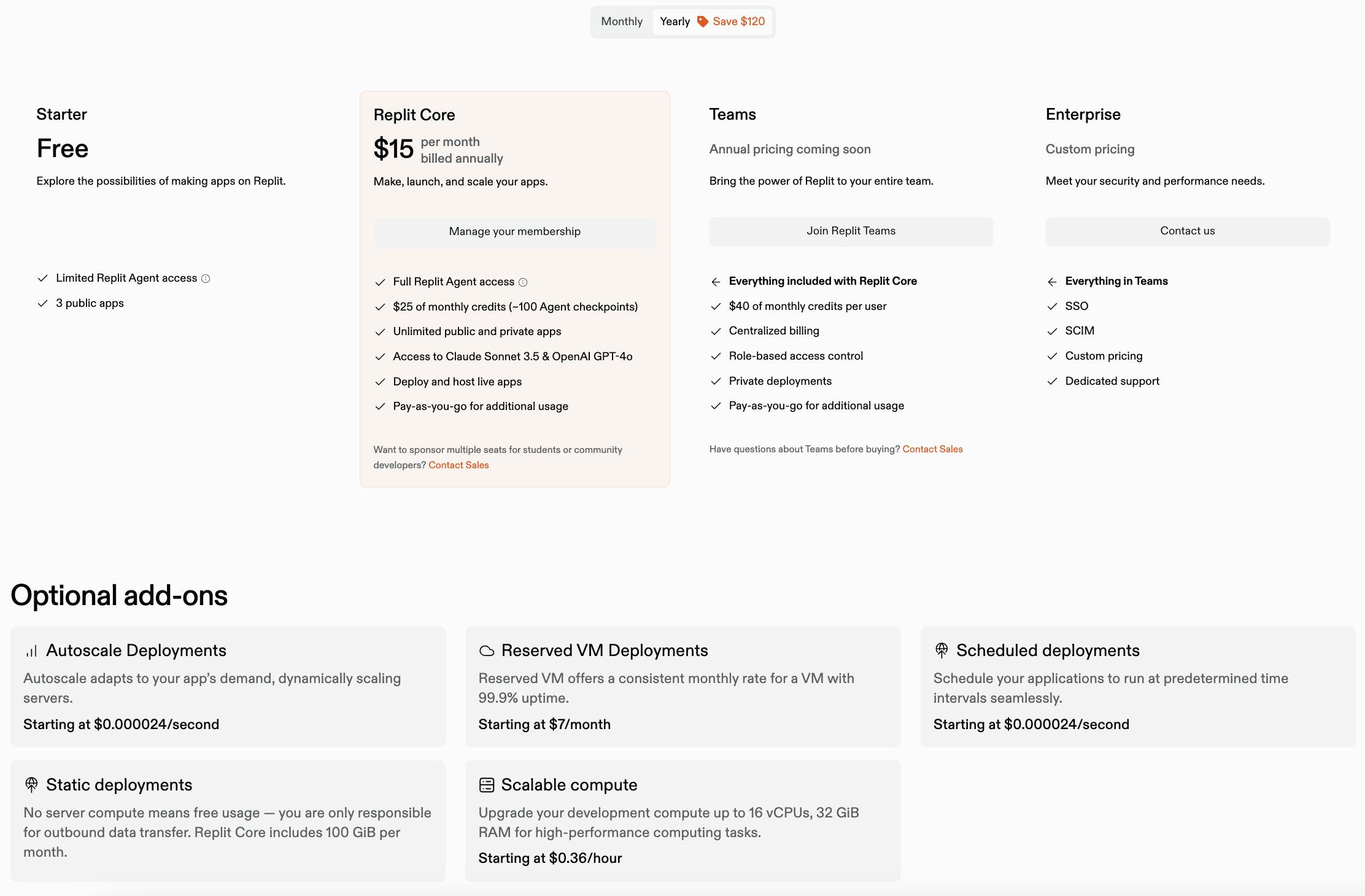
Source: Replit
Replit’s long-term intention is not to push monetization through subscriptions. In November 2020, Replit CEO, Amjad Masad, indicated that the company intends to make its coding environment free for every user, and instead generate revenue from programmers that host and run their applications from the cloud. Today, that vision will likely be executed by pushing for more monetization via Replit Deployments.
Traction
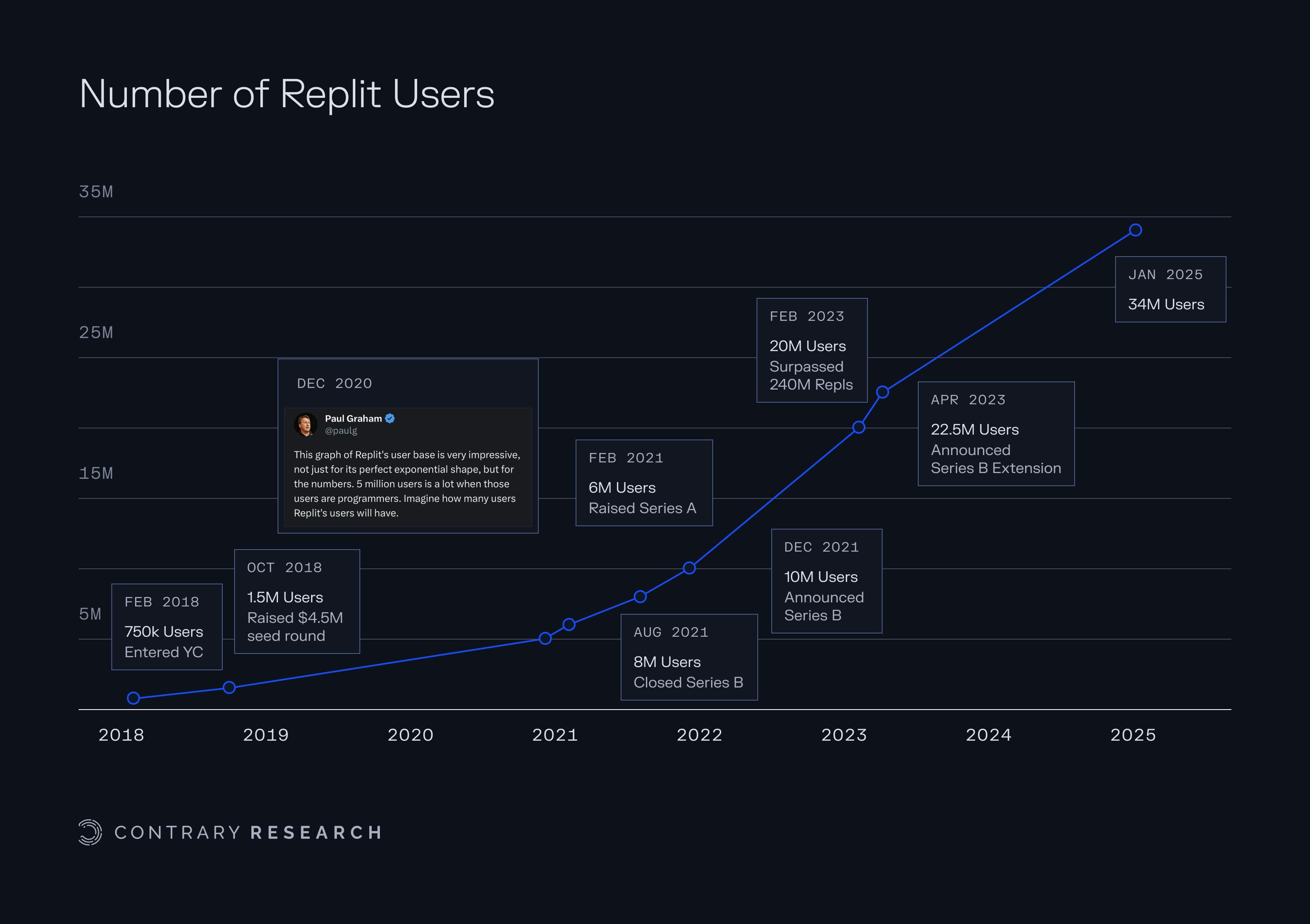
Source: Not Boring, Replit, Peter Yang; Contrary Research
Over the course of 2021, Replit doubled its user base from 5 million to 10 million by December 2021. In April 2023, Replit’s user base had grown to 22.5 million users across 200+ countries. By January 2025, Replit had grown to 34 million users and, according to the company, just a month later was nearing 40 million users. Replit users had contributed to building 235 million projects by April 2023 and collectively had 25 billion monthly external visits to apps and sites hosted on Replit as of April 2023. In July 2023 Replit indicated an 80% quarter-over-quarter growth rate in AI projects on Replit; a 34x increase year-over-year. As of January 2025, Replit indicated it had grown its revenue by five-fold.
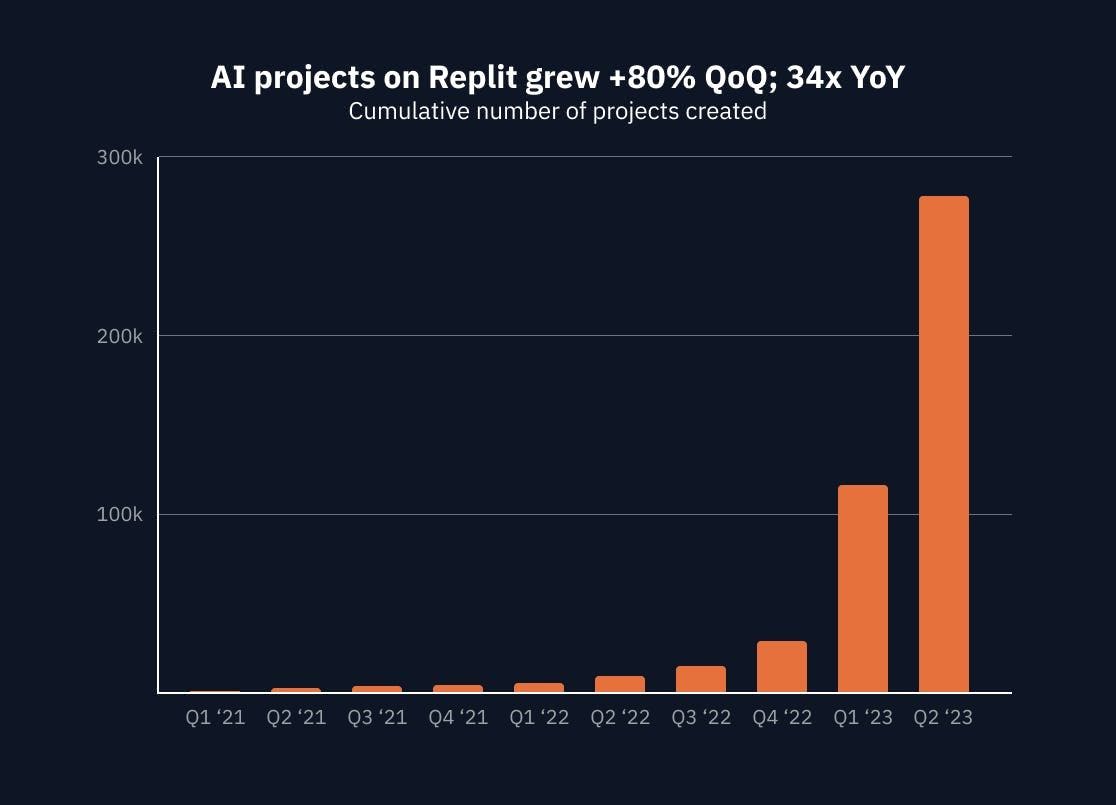
Source: Replit
In April 2023, Replit announced a partnership with Chroma so that “developers can easily create AI applications with state and memory.” In September 2023, Replit announced Replit ModelFarm to enable users to create generative AI applications. Most generative AI applications require extensive API key management. With ModelFarm, users can assess 3rd-party generative AI models, such as Google Cloud Vertex AI.
Valuation
In October 2016, Replit raised a $600K pre-seed round from Bloomberg Beta at a $6 million valuation. When working in the New York tech scene, Amjad had gotten to know Olivier Pomel, the CEO of Datadog, who later became an investor. Around the same time, the company received its first rejection from Y Combinator. Eventually, in January 2018 Replit was accepted into Y Combinator before eventually raising a seed round from a16z in October 2018. In the spring of 2019, when Replit had less than 5 million users, the company received a $1 billion acquisition offer, which it turned down.
Replit raised a $20 million Series A about two years later from A.Capital Ventures. Later that same year, in December 2021, the company raised an $80 million Series B from Coatue at an $800 million valuation. In April 2023, after significant correction in the private tech market, Replit raised a $97.4 million Series B extension at a $1.2 billion valuation led by a16z with participation from investors like Khosla Ventures, Naval Ravikant, ARK Ventures, and Contrary. In November 2023, the company raised a $20 million Venture Round led by Craft Ventures; the purpose of this round was not to raise money but rather to create more liquidity for Replit’s longer-term employees.
Key Opportunities
AI-Driven Innovation & Monetization
Replit is uniquely positioned to capitalize on the explosion of AI use cases in software development. The company could continue to integrate the cutting edge of AI into its product. The market for AI-assisted development is estimated to reach $43 billion by 2028. The use cases there extend beyond simple code completion to broader environment setup, debugging, and deployment. Each of Replit’s products are positioned in different aspects of that growth. AI capabilities could deepen Replit’s ability to monetize as users are more willing to pay for those capabilities as well.
Enterprise Adoption
As Replit works to enable more software creators one of the key places those people exist are within enterprises. Replit has already seen internal innovators at companies like Google and Coinbase building applications. On top of that, Replit has demonstrated that integrated AI can yield >30% productivity gains. The company could adopt a blended bottom-up adoption that culminates in top-down deals. As more internal software creators adopt Replit, it could encourage large enterprises to sign larger contracts to make Replit available for more of their employees. In addition, corporate partnerships like a partnership with Google Cloud could provide embedded offerings for Replit.
One key use case for non-technical users leveraging Replit Agent is jumping right to having a prototype for a specific project. Increasingly, that could mean Replit could be the starting point for internal projects rather than mocking up potential applications in a tool like Figma. If more non-technical users are able to prototype more rapidly, that could open up a meaningful opportunity within enterprises for Replit.
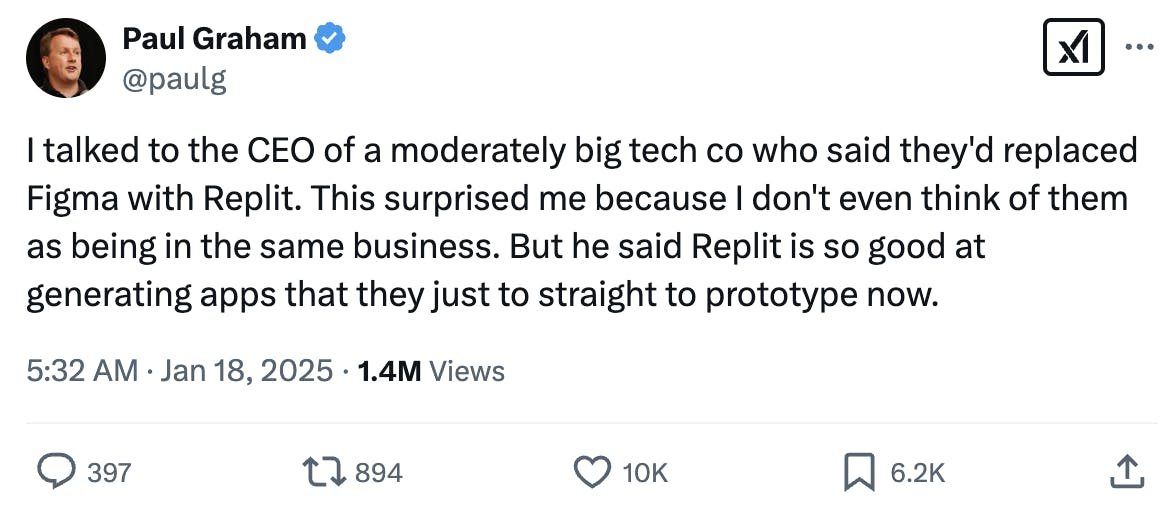
Source: X
Platform Ecosystem & Marketplace
Replit’s core value proposition today is providing an end-to-end framework to take software from idea to deployment. Over time, Replit could build a broader marketplace for applications. The groundwork is there: Replit already hosts apps that anyone can run or fork, and the concept of “remixing” is one Amjad talks about frequently. If Replit evolves this into an “App Store” for Repls, developers could monetize their creations directly on the platform. That could attract more serious builders who could see opportunities to monetize their creations. This would also be in line with Amjad’s vision of “democratizing access to the wealth creation engine of software.”
Global Expansion & Emerging Markets
Because Replit is browser-based and low-friction, it has a unique advantage in emerging markets where traditional development environments are hard to set up. As internet access expands in regions like Africa, South Asia, and Latin America, Replit can position itself as the development platform of choice for the next billion internet users. By providing localized language support, local server infrastructure (for speed), and perhaps partnerships with telecoms or governments (for educational programs), Replit could make meaningful in-roads into these untapped markets.
Affordability of Access
Replit’s product has been purpose-built for users across all types of internet connection and device access. In India alone, there were 200 million people who became internet users between 2022 and 2023. Products like Starlink will only increase internet access globally. Replit’s offerings, such as international data centers, and a fully functional mobile app play on these trends towards increased internet access and interest in software development. Increased emphasis on access to laptops, and low-cost products like Chromebooks, will only accelerate that access. Many of the users who are benefitting from increased internet and device access are already within Replit’s target demographic. As these demographics grow, there is an opportunity for Replit to continue to expand its international penetration.
Key Risks
Regulatory Headwinds For Generative AI
After the launch of GitHub Copilot in June 2021, GitHub, as well as parent company Microsoft, and AI partner OpenAI, are all the targets of a lawsuit “alleging Copilot regurgitates licensed code without giving credit to creators.” If the lawsuit results in an unfavorable decision against code assistants, like Copilot, that could have negative ramifications for Replit Ghostwriter.
In September 2023, Microsoft indicated that, if any users of GitHub Copilot face legal action, they can turn to the company, and Microsoft will “assume legal responsibility.” While this could potentially limit the concerns of users of Copilot, the same may not be true of smaller companies like Replit. Replit may not be able to bear the burden of legal action against Ghostwriter users.
As of February 2025, the class-action lawsuit against GitHub Copilot, Microsoft, and OpenAI remains active. As the case progresses, it continues to be a focal point in the broader debate over the ethical and legal considerations of training AI systems on publicly available code. The legal community and technology industry are closely monitoring the proceedings, as the outcomes may set important precedents for the use of open-source code in AI development.
Limitations of Generative AI
As more and more investment is poured into AI one of the unanswered questions is the lift in productivity. While a number of developers indicate a gain in productivity, there are also reports that the use of tools like GitHub Copilot results in 41% more bugs. In addition, one report from Snyk indicated that over 20% of users of AI code generation frequently see an increase in vulnerabilities. General adoption of AI will require these types of obstacles.
Evolving Competitive Landscape
While Replit experienced some first-mover advantage in providing a browser-based IDE, there is still a lot that competitive products have done to keep up. In particular, given the increasing commoditization of AI models, other code agents or low code development platforms are able to leverage the same underlying platforms as Replit Agent (e.g. Claude 3.5 Sonnet or, increasingly, Claude 3.7 Sonnet). Replit will have to continue to demonstrate its ability to differentiate from other products on the market.
Summary
From the earliest days of computing, the vision was autonomous agents acting independently of direct human direction. As LLMs have advanced, the possibility of that type of agentic capability is becoming more realistic. The ability to automate aspects of the software development process dramatically increases the market size for software.
Replit’s goal is to provide an end-to-end platform for taking software from idea to production, functioning essentially as an AI app builder. By pushing forward the quality of software being generated, adding capabilities around building specific types of apps and databases, and providing the ability to deploy and host applications, Replit’s goal is to power a new wave of software creators with differing programming knowledge.
Going forward, Replit has the opportunity to address the growing demand for AI-generated code across everything from enterprise use cases to emerging markets and a variety of business processes. At the same time, the company will have to find ways to stand out in an increasingly competitive market that includes a number of players using the same underlying technology. If Replit can position itself as the go-to choice for software creators, it can become a key part of the expansion in demand for software.
*Contrary is an investor in Replit through one or more affiliates.



